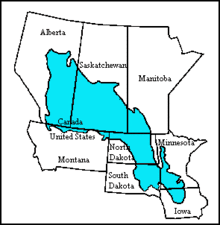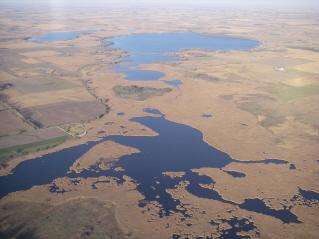Prairie Pothole Region
The Prairie Pothole Region (PPR) is an expansive area of the northern Great Plains that contains thousands of shallow wetlands known as potholes. These potholes are the result of glacier activity in the Wisconsin glaciation, which ended about 10,000 years ago. The decaying ice sheet left behind depressions formed by the uneven deposition of till in ground moraines. These depressions are called potholes, glacial potholes, kettles, or kettle lakes. They fill with water in the spring, creating wetlands, which range in duration from temporary to semi-permanent.[1] The region covers an area of about 800,000 sq. km and expands across five U.S. states (Minnesota, Iowa, North and South Dakota, and Montana) and three Canadian provinces (Saskatchewan, Manitoba, and Alberta). The hydrology of the wetlands is variable, which results in long term productivity and biodiversity. The PPR is a prime spot during breeding and nesting season for millions of migrating waterfowl.[2]


Hydrology
Few natural surface water drainage systems occur in the region as pothole wetlands are not connected by surface streams. They receive most of their water from spring snowmelt and precipitation.[3] Some pothole wetlands also receive groundwater inflow, so they typically last longer each year than those that only receive water from precipitation. Shorter-duration wetlands fed only by precipitation typically are sources of groundwater recharge.[4] The hydrology of the potholes is very variable, responding to changes in precipitation and groundwater, and results in regular wet-and-dry cycles.[5]
Vegetation
The vegetation of the PPR is emergent plants and tall grasses. The prairie land surrounding the region has dense grassland vegetation. As mentioned previously the vegetation is heavily affected by the amount of water available. In particularly wetter wetlands that retain water through the summer, the common plant is hard-stem bulrush,[6] along with soft-stem bulrush and common threesquare in slightly drier regions of the wetlands.[6] The vegetation in permanently flooded wetlands is more aquatic; duckweeds, pondweeds, aquatic buttercups, and aquatic smartweeds are some of the most common.[6] In drier wetlands of the PPR, the vegetation varies from spikerush, which is found in the wetter areas of the wetland, to foxtail barley and wheatgrass on the outer edges of the wetland.[6] The variable hydrology of the Prairie Pothole Region allows for an abundant seed bank under the soil. This allows for different vegetation to grow depending on the amount of water.[7] During times of drought when the basins dry up the vegetation does not die off, but in fact the seeds and root systems remain intact in the basin. When the water returns the plants grow and thrive once again.[7]
Wildlife
The Prairie Pothole Region provides important habitats for migratory waterfowl and other wildlife, supporting more than 50% of North America's migratory waterfowl.[8] The Prairie Pothole Region is one of North America's most important areas for duck reproduction. Although the region contains only about one-tenth of the continent's habitat area for breeding of waterfowl, roughly half the primary species of game ducks on the continent breed there. The region accounts for more than 60% of the breeding populations of mallard, gadwall, blue-winged teal, northern shoveler, northern pintail, redhead, and canvasback ducks.[9] The waterfowl time their breeding around the wetlands in this region. They use the wetland as their primary breeding grounds.
Threats
The location of the PPR is the main reason as to why the wetlands are in danger. More than half of the potholes have been drained and converted to agriculture,[4][8] causing pothole loss upwards to 90% or more in places.[10] As agriculture has expanded around the area the potholes were drained. The remaining wetlands of the region are feeling the effects from the surrounding agriculture. The runoff from chemicals, excess sediment, and nutrient flow into the potholes causes irreparable damage.[11] Climate change is another big culprit for the decline of the PPR. Climate change has caused more of the wetlands to dry earlier in the year. This affects the migration pattern for waterfowl that time their breeding to the seasonal presence of water in the PPR. Climate change has caused more wetlands to become seasonal wetlands as the increase in temperature is drying more and more wetlands. This has caused ripple effects within the migratory waterfowl breeding pattern as they use the wetlands as their primary breeding grounds. Decline in the Prairie Pothole Region, due to climate change and agriculture, will affect the migrating and breeding habits of waterfowl in that area.[12]
References
- Johnson, W. Carter; Millet, Bruce V.; Gilmanov, Tagir; Voldseth, Richard A.; Guntenspergen, Glenn R.; Naugle, David E. (2005). "Vulnerability of Northern Prairie Wetlands to Climate Change". BioScience. 55 (10): 863. doi:10.1641/0006-3568(2005)055[0863:vonpwt]2.0.co;2. ISSN 0006-3568.
- "Prairie Pothole Region". www.ducks.org. Retrieved 2019-11-13.
- "Comprehensive Report Ecological System - Great Plains Prairie Pothole". explorer.natureserve.org. Retrieved 2019-12-02.
- Euliss, Jr., Ned H.; Wrubleski, Dale A.; Muchet, David M. (1999). "Wetlands of the Prairie Pothole Region: Invertebrate species composition, ecology, and management". In Batzer, Darold P.; Rader, Russell B.; Wissinger, Scott A. (eds.). Invertebrates in freshwater wetlands of North America: Ecology and management. John Wiley and Sons. pp. 471–514. ISBN 978-0-471-29258-6. Retrieved 22 November 2019.
- Mitsch, William; Gosselink, James (2015). Wetlands (5th ed.). Hoboken, New Jersey: Wiley. pp. 61–62. ISBN 978-1-118-67682-0.
- Webmaster, David Ratz. "Montana Field Guide". fieldguide.mt.gov. Retrieved 2019-12-02.
- "prairie potholes". forestandrange.org. Retrieved 2019-12-02.
- The Prairie Pothole Region, archived copy of page from former National Biological Information Infrastructure website
- Austin, Jane E. 1998. Highlight Box: Waterfowl in the Prairie Pothole Region. Archived 2011-06-29 at the Wayback Machine Pages 456-457 in M. J. Mac, P. A. Opler, C. E. Puckett Haecker, and P. D. Doran, eds. Status and Trends of the Nation's Biological Resources, Vol. 2. Jamestown, ND: Northern Prairie Wildlife Research Center Online. "Archived copy". Archived from the original on 2006-02-13. Retrieved 2011-02-11.CS1 maint: archived copy as title (link) (Version 21JAN2000).
- "Wetlands". Fact Sheets. Minnesota River Basin Data Center, Minnesota State University, Mankato. 2004-11-15. Retrieved 2008-05-20.
- "Prairie Potholes". National Wildlife Federation. Retrieved 2019-12-02.
- Niemuth, Neal D.; Fleming, Kathleen K.; Reynolds, Ronald E. (2014-06-17). "Waterfowl Conservation in the US Prairie Pothole Region: Confronting the Complexities of Climate Change". PLOS ONE. 9 (6): e100034. Bibcode:2014PLoSO...9j0034N. doi:10.1371/journal.pone.0100034. ISSN 1932-6203. PMC 4061047. PMID 24937641.
External links
- "The Small Wetlands Program: A Half Century of Conserving Prairie Habitat". National Wildlife Refuge System. U.S Fish & Wildlife Service. Retrieved 9 July 2018.
- "Welcome to the Prairie Pothole Joint Venture". Prairie Pothole Joint Venture. Retrieved 9 July 2018.
- "Prairie Potholes". Wetlands. United States Environmental Protection Agency. 2016-10-06. Retrieved 2018-07-09.
- America’s Grasslands: A Threatened National Treasure Documentary produced by Prairie Public Television
- Land-use Change, Economics, and Rural Well-being in the Prairie Pothole Region of the United States United States